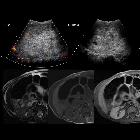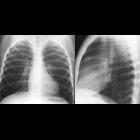Nephroblastomatose






Nephroblastomatosis refers to diffuse or multifocal involvement of the kidneys with nephrogenic rests (persistent metanephric blastema).
Epidemiology
Nephrogenic rests are found incidentally in 1% of infants.
Pathology
Nephrogenic rests are foci of metanephric blastema that persist beyond 36 weeks of gestation and have the potential for malignant transformation into Wilms tumor.
It is currently believed that nephrogenic rests give rise to approximately 30-40% of Wilms tumors. Nephrogenic rests are found in up to 99% of bilateral Wilms tumors.
There are two pathologic subtypes of nephrogenic rest, perilobar rest (90%) and intralobar rest (10%), the latter being more associated with Wilms tumor.
Associations
Radiographic features
Ultrasound
Ultrasound may demonstrate hypoechoic nodules but is less sensitive than MR imaging and CT. Diffuse nephroblastomatosis is usually seen as reniform enlargement with a thick peripheral rind of tissue that may show striated enhancement. On ultrasound, the enlarged kidney may have diffusely decreased echogenicity.
CT
At CT, macroscopic nephrogenic rests appear as low-attenuation peripheral nodules with poor enhancement relative to that of adjacent normal renal parenchyma.
MRI
Typical signal characteristics include:
- T1: the nodules demonstrate low-signal-intensity foci
- T2: the nodules demonstrate low-signal-intensity foci
- T1 C+ (Gd): hypointense mass enhances less than renal tissue
Treatment and prognosis
Treatment for nephrogenic rests is controversial. Some investigators recommend chemotherapy, whereas others maintain that close serial radiologic evaluation of enlarging masses is sufficient.
Differential diagnosis
- renal lymphoma can mimic the appearance of nephroblastomatosis but is unusual in infants and young children.
See also
Siehe auch:
- Lymphom der Niere
- Beckwith-Wiedemann-Syndrom
- Nephroblastom
- metanephric blastema
- Hemihyperplasie
- drash syndrome
- WAGR syndrome
- paediatric cystic renal diseases
- sporadic aniridia
und weiter:

 Assoziationen und Differentialdiagnosen zu Nephroblastomatose:
Assoziationen und Differentialdiagnosen zu Nephroblastomatose:



